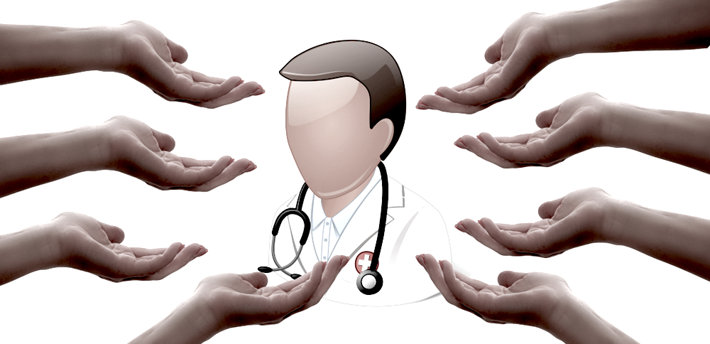What Doctors Can Do to Curb Opioid Addiction

The United States of America is in the process of struggling with its worst-ever drug and alcohol addiction epidemic. Few are denying that truth. According to the Substance Abuse and Mental Health Services Administration, there are more than twenty-five million Americans who are currently addicted to drugs and alcohol, a very significant percentage of the adult and teen population. It translates to about fifteen percent of the U.S. population that is over the age of twelve. Since 2001, more than six-hundred-thousand Americans have lost their lives from drug abuse, and tens of millions of families have been negatively affected by this growing epidemic.
At the forefront of the addiction crisis, opioid-based drugs have consistently rung out time and time again as being the most prominent drugs in question. Without a doubt, opioids were the key problem factor, the key drugs that were easily causing the most trouble and the greatest levels of difficulty for all concerned.
Finally, in October of 2017, President Trump delivered a nationwide address, announcing publicly that the opioid problem would be correctly labeled a “National Public Health Emergency.” However, the U.S. has been struggling with opioids for a very long time. We’ll take a look at the part the medical industry has played in the problem, how we got to where we are now, and where things are likely to go with the opioid problem now that the matter has been properly recognized on the White House level.
The opioid addiction epidemic is now so serious that it will likely take years and massive levels of effort to reduce this problem. This is not something that is going to go away overnight. Not by a long shot. Thankfully, doctors can step in and help reduce this problem. And they absolutely should too.
Doctors Need to Do Their Part to Reduce the Addiction Epidemic

Doctors and all medical practitioners for that matter need to do their part to reduce the opioid epidemic. This has been a crippling, nightmare of a problem, a problem that has encapsulated a significant percentage of Americans and which has caused endless heartbreak, turmoil, deaths, and socioeconomic destruction.
Doctors can take a few different steps to curb the opioid epidemic. Written out below are just three, initial, immediate policies and efforts that doctors all across the country could take to significantly reduce the opioid epidemic. There are more than nine-hundred-thousand practicing doctors in the U.S. If each doctor followed the following strategies, we would absolutely see a reduction in the opioid epidemic.
Make Full Use of Prescription Drug Monitoring Programs
Prescription Drug Monitoring Programs, abbreviated PDMPs, are essentially special database computer programs that seek to help doctors determine if their patients have been getting certain prescriptions from other doctors or not. PDMPs are a watchdog approach, a method of determining if patients are “doctor shopping” or not. Doctor shopping is when a patient will jump from one doctor to the next, or when a patient will use multiple doctors at once, all in an effort to get a hold multiple prescriptions for addictive drugs for their own use or for resale on the street.
PDMP database programs are now active in all U.S. states. The only problem is, PDMPs are not mandatory or required. Doctors can voluntarily sign up for them if they want. They do not cost anything, and doctors everywhere are encouraged to use them. It’s actually a little bit ludicrous that doctors would not want to use them. One of the first steps that doctors could take in reducing the prescription drug addiction epidemic and the opioid epidemic would be to start making full use of PDMPs immediately.
Be Far More Restrictive in Prescribing Trends

One of the main reasons why we got into the addiction epidemic that we are in was because doctors have been prescribing too much pain medicine, in too high of dosages, for too long, to patients who did not need really them. In fact, research indicates that the top, three reasons why patients seek help for pain is because of back pain, headaches, and jaw/teeth pain.
What is truly remarkable about all of this is that most high-strength pain relievers like OxyContin, Vicodin, Percocet, Dilaudid, Opana, Morphine, and the other pain relievers are not even intended to address such pain phenomena. In fact, medical texts tell us that these pain phenomena are more appropriately addressed with over-the-counter, low-strength pain relievers like Advil, Aspirin, Aleve, etc.
With that data in mind, doctors need to start being much more frugal and restrictive in their prescribing trends. There is no reason to prescribe drugs in such high-strength dosages, not by any means. When patients have the opportunity to get low-strength pain relief and when patients are encouraged to explore over-the-counter pain relief, this drastically reduces the addiction risk at hand.
Explore Other Options for Pain Relief
Another approach that doctors need to take is to actually recommend that patients utilize alternative, holistic, and natural methods of pain relief. Doctors need to move in a direction of completely taking opioids off the table as far as drug use trends go. Doctors should start advising patients to pursue holistic remedies for pain, remedies that have absolutely no addiction risk and very little, if any, side effects as well. Some of the alternative methods of pain relief that doctors can begin recommending are methods like:
- Acupuncture
- Exercise
- Turmeric
- Valerian Root
- Cats Claw
- Magnesium
- Ginger
- Capsaicin
- Chiropractic manipulation
- Other supplements and vitamins
- Stress-reduction techniques
- Massage therapy
- Physical therapy
And that is just a brief list. There are many other methods of pain relief that are workable and appreciated, but these methods are rarely explored as they fly in the face of modern-day medicine and pharmaceutical approaches.
Using the Medical Community to Reduce the Opioid Epidemic

The opioid epidemic was partially caused by the medical industry and the pharmaceutical companies, so it would seem fitting if the medical experts were the ones to reduce this problem. Now more than ever, something has to be done about the issue of the opioid epidemic, as these problems are only getting worse and worse as the years go by.
The medical community, all told, is a community of several million experts. This community can and should make a difference in how we approach medicine, as it could not be more clear than it is now that the opioid pain reliever route is just not working for us.
To make their efforts easier and more strongly supported, the American people need to insist on better care, particularly when it comes to treating pain. We need pain relief solutions that do not lead down a dark path to addiction. We need pain relief options that are natural, that are holistic, and that are not based on the very same drugs that go into heroin and highly lethal, synthetic opioids. We need to consistently ask for these types of medical remedies, and we need to start saying no to opioids.
Public opinion is already starting to shift against opioid pain relievers. It is only a matter of time before the entire nation changes towards non-opioid-based solutions. We need to be that change.
Sources:
- https://www.drugabuse.gov/publications/research-reports/misuse-prescription-drugs/how-can-prescription-drug-misuse-be-prevented
- https://www.vox.com/science-and-health/2018/2/12/16998122/opioid-crisis-oxycontin-purdue-advertising
- https://www.webmd.com/mental-health/addiction/painkillers-and-addiction-narcotic-abuse#1


 ®
®